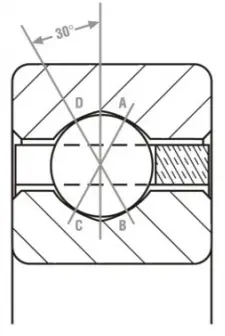Are Type X Thin Section Bearings Suitable For High-Speed Operations?
Type X thin section bearings have garnered significant attention in the world of precision engineering and high-speed applications. These specialized bearings are designed to offer exceptional performance in scenarios where space is at a premium, yet high rotational speeds are required. As industries continue to push the boundaries of machinery efficiency and compactness, the question of whether Type X thin section bearings are suitable for high-speed operations becomes increasingly relevant. This blog post delves into the characteristics, applications, and considerations surrounding these innovative bearings, providing insights for engineers and designers seeking optimal solutions for their high-speed challenges.

What are the key advantages of Type X thin section bearings in high-speed applications?
Type X thin section bearings offer several distinct advantages that make them particularly well-suited for high-speed applications. Their unique design and construction contribute to a range of benefits that can significantly enhance the performance and efficiency of various machinery and equipment operating at high rotational speeds.
One of the primary advantages of Type X thin section bearings is their compact profile. As the name suggests, these bearings are characterized by their thin cross-section, which allows for significant space savings in machine designs. This feature is particularly valuable in applications where weight reduction and miniaturization are critical factors. The reduced mass of these bearings also contributes to lower inertia, allowing for quicker acceleration and deceleration in high-speed operations.
Another key advantage is the enhanced precision and stability offered by Type X thin section bearings. Their design typically incorporates high-quality materials and precision manufacturing techniques, resulting in bearings with excellent roundness and minimal runout. This precision is crucial in high-speed applications, where even small imperfections can lead to vibrations, noise, and reduced efficiency. The stability provided by these bearings helps maintain accurate shaft positioning, which is essential for many precision instruments and machinery operating at high speeds.
How do Type X thin section bearings compare to traditional bearings in terms of speed capabilities?

When comparing Type X thin section bearings to traditional bearings in terms of speed capabilities, several factors come into play. Understanding these differences is crucial for engineers and designers who need to select the most appropriate bearing type for their high-speed applications.
One of the most significant advantages of Type X thin section bearings over traditional bearings is their ability to operate at higher speeds while maintaining a compact profile. Traditional bearings, such as deep groove ball bearings or roller bearings, often have larger cross-sections and greater mass. This increased mass can lead to higher inertia and greater centrifugal forces at high speeds, potentially limiting their maximum operational speed. In contrast, the reduced mass and slim profile of Type X thin section bearings allow them to achieve higher rotational speeds with less inertia and lower heat generation.
The design of Type X thin section bearings also contributes to their superior speed capabilities. These bearings often feature optimized internal geometries that reduce friction and allow for more efficient operation at high speeds. For example, they may have specially designed ball paths or roller profiles that minimize skidding and promote smooth rolling contact. Traditional bearings, while robust and versatile, may not have these specialized features tailored for high-speed performance.
Another aspect to consider is the heat generation and dissipation characteristics of the bearings. High-speed operation inevitably leads to increased heat generation due to friction. Type X thin section bearings, with their reduced mass and optimized designs, often generate less heat compared to traditional bearings operating at similar speeds. Additionally, some Type X bearings incorporate advanced materials or coatings that enhance heat dissipation, further improving their high-speed performance. Traditional bearings may require more extensive cooling systems or lubrication to manage heat at comparable speeds.
Lubrication is another critical factor in high-speed bearing performance. Type X thin section bearings are often designed with advanced lubrication systems or materials that allow for efficient lubrication even at high speeds. Some variants may use specialized greases or oil systems that can withstand the centrifugal forces and temperatures associated with high-speed rotation. Traditional bearings may face challenges in maintaining proper lubrication at extreme speeds, potentially limiting their maximum operational capabilities.
The precision and manufacturing tolerances of Type X thin section bearings also contribute to their superior speed capabilities. These bearings are often manufactured to tighter tolerances than many traditional bearings, resulting in better roundness, smoother surfaces, and more precise clearances. These factors are crucial for maintaining stability and reducing vibration at high speeds. While high-precision traditional bearings are available, they may not match the combination of precision and compact design offered by Type X thin section bearings.
It's important to note that while Type X thin section bearings generally offer advantages in high-speed applications, traditional bearings still have their place. Traditional bearings often excel in applications requiring high load capacity or where space constraints are less critical. They may also be more cost-effective for lower-speed applications or in scenarios where their robustness and versatility are more valuable than the specialized high-speed capabilities of Type X bearings.
The choice between Type X thin section bearings and traditional bearings for high-speed applications ultimately depends on the specific requirements of the application. Factors such as load capacity, space constraints, precision requirements, and operational conditions all play a role in determining the most suitable bearing type. In many cases, Type X thin section bearings offer a compelling solution for applications demanding high speeds in compact spaces, but a thorough analysis of the application's needs is essential to make the optimal selection.

What factors should be considered when implementing Type X thin section bearings in high-speed machinery?
Implementing Type X thin section bearings in high-speed machinery requires careful consideration of various factors to ensure optimal performance, reliability, and longevity. Engineers and designers must take into account a range of technical and practical aspects when integrating these specialized bearings into their high-speed applications.
One of the primary factors to consider is the specific speed requirements of the application. While Type X thin section bearings are generally well-suited for high-speed operations, it's crucial to match the bearing's capabilities with the exact speed range of the machinery. This involves not only considering the maximum operational speed but also the acceleration and deceleration characteristics of the system. Engineers should consult the bearing manufacturer's specifications and conduct thorough calculations to ensure that the selected bearing can handle the anticipated speed profile without compromising performance or safety.
The load characteristics of the application are another critical factor. Although Type X thin section bearings excel in high-speed scenarios, they may have different load-bearing capabilities compared to larger, traditional bearings. It's essential to analyze both the radial and axial loads that the bearing will experience during operation. This analysis should account for static loads, dynamic loads, and any potential shock loads or vibrations. Ensuring that the selected bearing can handle these loads while operating at high speeds is crucial for preventing premature failure and maintaining system reliability.
Temperature management is a significant consideration when implementing Type X thin section bearings in high-speed machinery. High rotational speeds inevitably generate heat through friction, and effective heat dissipation is crucial for maintaining bearing performance and longevity. Engineers should evaluate the thermal characteristics of the bearing and the surrounding components, considering factors such as material thermal conductivity, lubricant properties, and potential cooling mechanisms. In some cases, additional cooling systems or heat-resistant materials may be necessary to manage the thermal load effectively.
Lubrication is another critical factor that requires careful consideration. The choice of lubricant and lubrication method can significantly impact the performance of Type X thin section bearings in high-speed applications. Factors such as lubricant viscosity, operating temperature range, and compatibility with bearing materials must be evaluated. In some high-speed scenarios, oil-mist lubrication or specialized grease formulations may be necessary to ensure adequate lubrication without excessive heat generation or lubricant breakdown. The lubrication system should also be designed to withstand the centrifugal forces associated with high-speed rotation.
Precision and alignment are paramount when implementing Type X thin section bearings. These bearings often operate with very tight tolerances, and even small misalignments can lead to increased vibration, noise, and premature wear. Engineers must ensure that the bearing housing, shaft, and related components are manufactured and assembled to the required precision standards. This may involve using advanced alignment techniques, precision machining, and potentially incorporating features that allow for fine adjustments during assembly or maintenance.
The environmental conditions in which the machinery will operate also play a crucial role in the implementation of Type X thin section bearings. Factors such as dust, humidity, chemical exposure, and temperature fluctuations can all impact bearing performance and lifespan. Engineers should consider appropriate sealing solutions to protect the bearings from contaminants and moisture ingress. In some cases, specialized materials or coatings may be necessary to withstand harsh environmental conditions while maintaining high-speed performance.
Maintenance and serviceability are practical considerations that should not be overlooked. While Type X thin section bearings are designed for high performance, they still require proper maintenance to ensure long-term reliability. Engineers should consider factors such as accessibility for inspection and replacement, compatibility with condition monitoring systems, and the ease of lubricant replenishment or replacement. Designing the machinery to facilitate easy maintenance can significantly reduce downtime and extend the overall system lifespan.
Finally, the overall system design and integration must be considered when implementing Type X thin section bearings. This includes evaluating the bearing's compatibility with other components such as seals, couplings, and drive systems. The compact nature of these bearings may allow for innovative design solutions, but it's essential to ensure that all components work together harmoniously at high speeds. Finite element analysis and other simulation techniques can be valuable tools for optimizing the overall system design and predicting performance under various operating conditions.
In conclusion, implementing Type X thin section bearings in high-speed machinery requires a comprehensive approach that considers speed requirements, load characteristics, thermal management, lubrication, precision, environmental factors, maintenance, and overall system integration. By carefully evaluating these factors and working closely with bearing manufacturers and system designers, engineers can successfully leverage the advantages of Type X thin section bearings to create high-performance, reliable, and efficient high-speed machinery.
Luoyang Huigong Bearing Technology Co., Ltd. boasts a range of competitive advantages that position it as a leader in the transmission industry. Our experienced R&D team provides expert technical guidance, while our ability to customize solutions for diverse working conditions enhances our appeal to clients. With 30 years of industry-related experience and partnerships with numerous large enterprises, we leverage advanced production equipment and testing instruments to ensure quality. Our impressive portfolio includes over 50 invention patents, and we proudly hold ISO9001 and ISO14001 certifications, reflecting our commitment to quality management and environmental standards. Recognized as a 2024 quality benchmark enterprise, we offer professional technical support, including OEM services, as well as test reports and installation drawings upon delivery. Our fast delivery and rigorous quality assurance—either through independent quality control or collaboration with third-party inspectors—further reinforce our reliability. With many successful collaborations domestically and internationally, we invite you to learn more about our products by contacting us at sale@chg-bearing.com or calling our hotline at +86-0379-65793878.
References
1. SKF Group. (2023). "Thin section bearings - High precision and space savings." SKF.com.
2. Kaydon Bearings. (2022). "Thin Section Bearings for High-Speed Applications." Kaydon.com.
3. NSK Americas. (2024). "Thin Section Bearings." NSK.com.
4. Schaeffler Group. (2023). "Thin section bearings - INA." Schaeffler.com.
5. NTN Corporation. (2022). "Thin-Section Ball Bearings." NTN Global.
6. The Timken Company. (2024). "Thin Section Bearings." Timken.com.
7. American Roller Bearing Company. (2023). "Thin Section Bearings." AMROLL.com.
8. RBC Bearings. (2024). "Thin Section Bearings." RBCBearings.com.
9. Machine Design. (2022). "Selecting and Applying Thin-Section Bearings." MachineDesign.com.
10. Bearing News. (2023). "The Advantages of Thin Section Bearings in High-Speed Applications." BearingNews.org.

